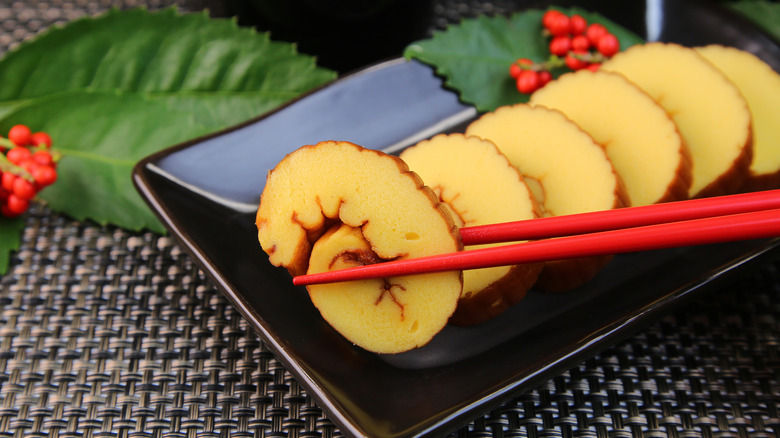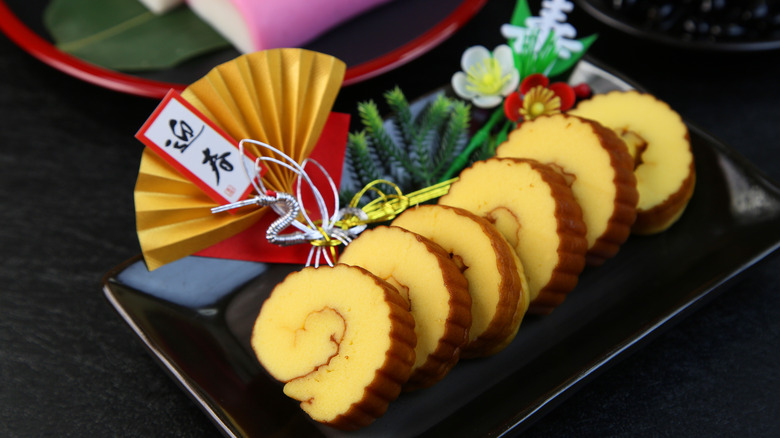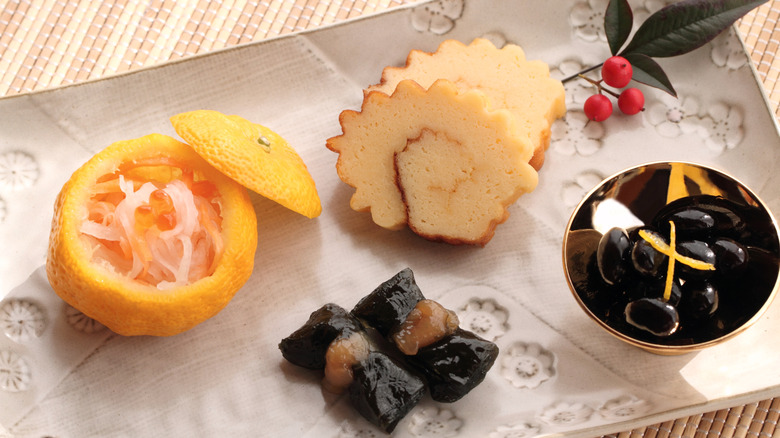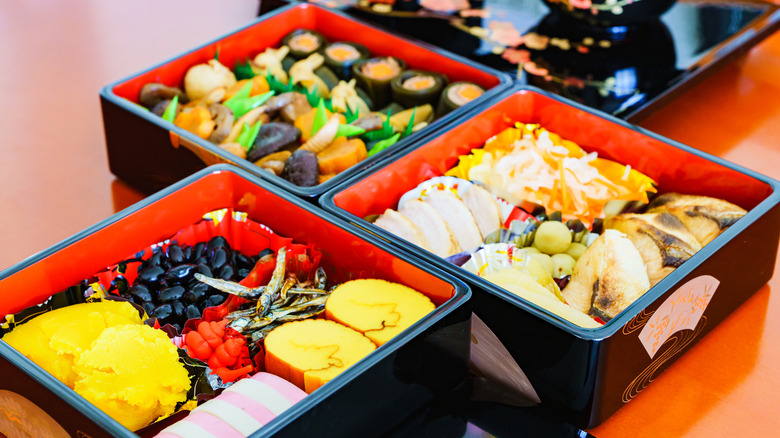Datemaki: The Japanese Rolled Omelet That's A New Year Tradition
Japanese food is a cuisine full of complex flavors, delicate and aesthetic presentation, and that unique umami taste. While Japan is known globally for its sushi and noodle dishes, like ramen, some of its egg dishes have also recently gotten internationally popular. From viral videos of cutting omurice (Japan's "exploding" omelet) open or people enjoying eating omusoba, the internet has been getting an education on Japanese egg dishes. The country is known for its rolled omelets, like tamagoyaki. Tamagoyaki can be packed in bento boxes or included on tables for breakfast. Similar to tamagoyaki, datemaki is another rolled omelet dish, but it is reserved for a more special occasion.
Datemaki is the sweet, fluffy, oven-baked omelet that is traditionally eaten on New Year's in Japan. The unique dish, according to MasterClass, is made with eggs, fish cake, soy sauce, and sweet seasonings to create a pleasantly sweet flavor and light, airy texture.
History of datemaki
According to Chopstick Chronicles, in the Edo period of Japan (the final era of the traditional Japanese culture, as per History), datemaki was called castella kamaboko, meaning fish cake. However, many people thought the dish resembled the pattern on the kimonos that stylish people of the time wore. These people were called "datemono," thus how the omelet got its name.
However, another theory about datemaki's namesake comes from a historical warlord. According to Food in Japan, warlord Date Masamune is said to have liked eggs with flounder meat. This dish was made by rolling the ingredients in a sushi mat, so it was called "Date maki," since maki means rolled in Japanese.
Traditionally, this dish is only eaten on New Year's in Japan. According to Chopstick Chronicles, one theory for this is that historically "important documents and pictures were always rolled into a scroll." This draws a similarity to how datemaki and other New Year's foods are made in the country. Just One Cookbook notes that the dish is thought to bring students good luck and success in academic life because of its resemblance to a scroll.
Ingredients in datemaki
The dish blends a variety of opposing flavors to create a unique product. The main ingredient in datemaki is, of course, eggs. Around four to five large eggs can be used for one roll, according to MasterClass.
The second main ingredient is hanpen. According to Just One Cookbook, hanpen is "made from grated Japanese yam (yamaimo) and surimi (Alaska Pollock), salt, and kombu dashi." The site says this ingredient adds a unique flavor to the omelet. Chopstick Chronicles also notes it adds an airy, soft, and fluffy texture.
Sugar, honey, and mirin are all added for sweetness. Lastly, soy sauce and dashi are added for that salty umami flavor. According to Chopstick Chronicles, Dashi is a "Japanese soup stock or broth which contains extracted Umami components such as amino acids and [flavors]." When combined, the datemaki has an overall sweet flavor with umami elements and an enjoyable, squishy texture.
How datemaki is made
The first step to making this annual indulgence is combining the main ingredients. You can use a tool like a food processor for this. In a bowl, blend eggs, fish cake, mirin, soy sauce, and sugar until smooth, according to MasterClass. Pour this eggy mixture through a fine-mesh strainer into a baking dish to ensure a velvety texture. Then, bake until it's golden. Once cooled, the fun yet tricky part begins.
Transfer the omelet onto a bamboo rolling mat. Use a sharp knife to make "shallow cuts along the surface of the omelet, about an inch apart, running parallel to the bamboo," according to the site. Chopstick Chronicles suggests wetting the bamboo mat before rolling to prevent the egg mixture from sticking to the mat and possibly tearing. Then roll tightly to form a cylinder. It must be chilled in this position, still wrapped in the mat, to ensure it holds its shape. After a couple of hours, it can be cut into the iconic round slices and served.



